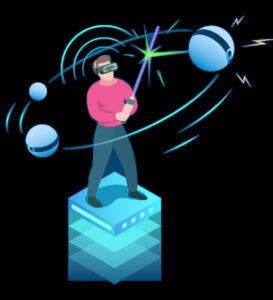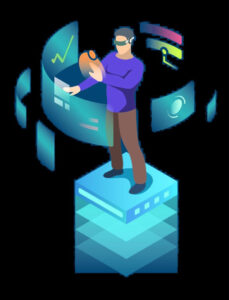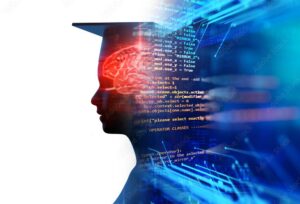What’s XR?
First, let’s talk a bit about the general field. XR is short for ‚Extended Reality‘. That is any setting, where reality is altered by means of special glasses (more). XR is the umbrella term for:

Augmented Reality
(AR)
Reality is being complemented by virtual elements, e.g. tooltips for objects in your field of view

Virtual Reality
(VR)
Complete immersion in a virtual world, where anything in your field of view is created by the computer

Mixed Reality
(MR)
Coined by Microsoft, in the broader sense a sophisticated AR approach, where the physical and the virtual world merge
At Weltenmacher, we happily employ any of the above depending on which approach is most suitable to create the best learning experience.
Benefits of XR trainings
Didactics in XR
Like in a flight simulator, the learners can experience situations similar to the real world. But in XR we can provide different learning modes: from passive to highly active, either with plenty of guidance or for the users on their own. They are allowed to make and learn from mistakes which in real life would be impossible, and they can train as long and often as they want.
On top of this the users can see what is hidden in real life: we can show what’s happening inside of a machines, pipes etc. or give additional info such as temperatures and a lot more.
Engagement
Every day, together with our partners and clients we experience how amazed and motivated the users are, to operate in a virtual environment.
No doubt: this significantly contributes to the learning success.
This basic feature of the technology is being topped of by elegant designs, an iteratively improved user experience and gamification elements.
Safety
You can train in perfectly safe environment, while you execute tasks, which in reality are highly risky, such as working in heights, operating heavy machinery or around an explosion threat. E.g. reported problems in health care are:
“No one should be harmed while receiving health care and yet globally, at least 5 patients die every minute because of unsafe care”, Dr. Tedros Adhanom Ghebreyesus WHO Director-General 17th Sep. 2019
“Insufficient training is one major reason”, WHO Report Medication Without Harm, 2018
Quality Management
Having standardized trainings combined with analytics, you can guarantee a quality standard for your trainings, as well as measuring the performance of the trainees. That allows you to ensure, that the training is complete and effective.
Costs
A VR training does need a one time hardware, which is available for less than EUR 400,-, so basically the price of new mid-range cell phone. After that you get a highly effective training, which exceeds results with traditional methods, since you are actually learning by doing with as many iterations as required.
‘Is VR soft skills training more effective than traditional training methods, and is VR soft-skills-training more cost-effective to deploy than traditional methods? – The answer to both questions is „yes“’ (see PWC study)
Academic Insights
- Virtual Reality Training Programs for Peritoneal Dialysis – only a Future Research?, Zgoura et. al, Medizinischer Kongress Kopenhagen, 2018
- Virtual Reality Simulation in Peritoneal Dialysis Training: The Beginning of a New Era, Zgoura/Hettich/Natzel/Özcan/Kantzow, Advances in CKD, 20191
- Virtual Reality (VR) in der Nephrologie, Zgoura/Kantzow/Westhoff, Thieme, 20202
- Virtual reality device training for extracorporeal membrane oxygenation, Wolff/Bruon/Reiter/Kantzow/Kelm/Jung, Critical Care, 2020
- Potentiale von Virtual, Augmented and Mixed Reality für HR, Jäger/Kantzow, 2021, Haufe

Virtual and Augmented Reality Markets (XR)
Global Medical Education
Market
$32 Bn
(growing at 4% CAGR)
Corporate E-Learning
Market
$50 Bn
(By 2026. Annual growth rate of 15% from 2020 to 2026)
